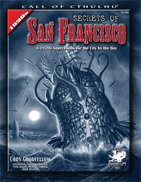
|
About OgreCave and its staff
|

|
by Demian Katz
Call of Cthulhu is traditionally a game of the east coast, with the majority of mind-shattering revelations taking place somewhere quiet in New England. However, there's no need for eldritch horror to restrict itself to one place, and Secrets of San Francisco seeks to open up a little piece of the west to investigators looking for a change of scenery. The book provides plenty of material to help run familiar types of adventures in a new setting and to explore the unique characteristics of the region.
Go West, Young Investigator Fiction is also fairly well-represented here. Scenario hooks are interspersed throughout the text - perhaps the high suicide rate at the Golden Gate Bridge has a supernatural origin, or perhaps a dark secret lies in the tunnels beneath the public Sutro Baths. Many of these suggestions are fairly obvious, but a few of them are gems. I particularly enjoyed one elaborate hook which brings together ghost sightings, the Chinatown tunnels, a smuggling operation where goods are hidden away in another dimension, and consequences of the 1906 earthquake. Links to other published Call of Cthulhu products are also present - a character from an adventure in the modern-day The Stars Are Right scenario collection shows up here at an earlier point in his life. There are also enough references to the Day of the Beast campaign that I began to find them annoying (though perhaps I would feel differently if I actually had a copy of that particular book on hand). In an interesting blend of fact and fiction, weird fiction author Clark Ashton Smith is covered as a potential NPC and characters from a couple of his more Lovecraftian stories are detailed in game terms. Overall, the fiction-based material in the book is less interesting and less useful than the factual material and tends to overstay its welcome a bit, but it doesn't waste too much space in a generally worthwhile volume.
Adventure! Mystery! Despair! (Spoiler Warning: Some minor plot points revealed below.) The first adventure, "The Ferry Ride," is by far the weakest. While it does succeed in providing a good excuse to bring a new group of investigators together and in setting up a potential campaign, it's not a very interesting adventure in and of itself. A Keeper might be able to build something from this, but it's really little more than an extended scenario hook. "The Westchester House" is a great improvement over the previous scenario. While it's a bit jarring that the scenario chooses to avoid using the historical Sara Winchester, instead renaming her Sarah Westchester, this is easily ignored. This is a purely mundane mystery adventure that should provide a pleasing change of pace for a party that's tired of being constantly devoured by invincible alien beings, and apart from being a bit sparse on the details of the titular house, it has enough information to work well as a stand-alone session. "The Colour of His Eyes," a guest adventure by Brian M. Sammons, is probably the best of the bunch - dealing with the consequences of looking through a very powerful and dangerous telescope, it has the investigators dealing with multiple threats, some more sympathetic than others. There are good opportunities for role-playing, strategy, and (of course) a bit of Lovecraftian horror. While all of the book interested me, this was the bit that most made me want to pick up some dice and run a game. Since it could easily be adapted to another setting by changing a few location names, I may end up using it someday even if I don't commit to a full San Francisco campaign. The final scenario, "Beyond the Edges," is by far the longest, taking up forty pages. It pulls the investigators first into the seedy underbelly of San Francisco, and then somewhere far, far worse. This is a reasonably well-constructed adventure, and I could see it filling a few sessions fairly satisfactorily, but it's not quite innovative enough to justify its length. The endgame, which is the most interesting portion of the adventure, seems the least developed, and some of the lengthy investigation leading up to this finale feels like it could have been trimmed back significantly, perhaps enough to make room for a fifth adventure. Not a failure, but not a stand-out either.
Finishing Touches
Conclusions
|
||||
 Secrets of San Francisco:
Secrets of San Francisco: